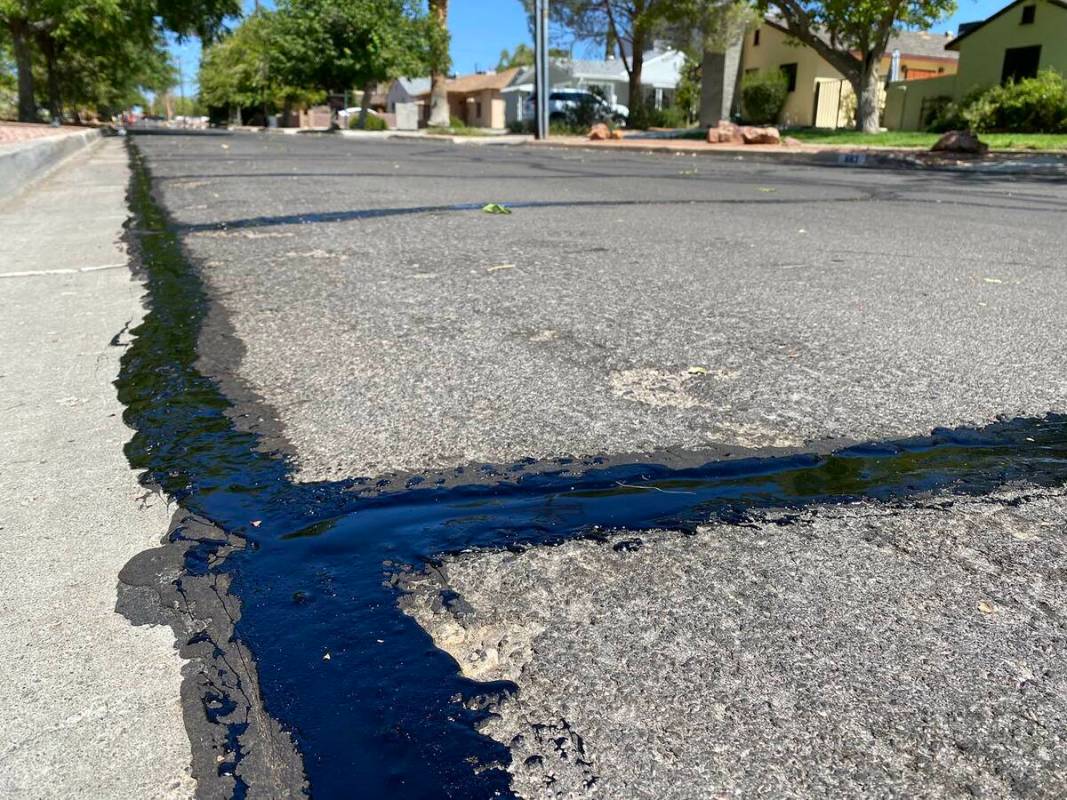
Boulder City is currently undergoing a crack and slurry seal project on our roadways. Asphalt patching started Sept. 13, followed by slurry sealing on Sept. 20 that should last about a month.
American Pavement Preservation, under contract with the city of Boulder City, is a leading company in the asphalt pavement preservation industry. Their president, Eric Reimschiissel, explained why sealing asphalt cracks is so important: “Cracks need to be sealed to prevent water from seeping into the aggregate base — making it wet and ‘mushy,’ and allowing the pavement to move and crack.”
Reimschiissel went on to describe how by sealing asphalt it also prevents “noncompressible” (rocks, sand, etc.) from getting into the cracks that would instigate more cracking as the asphalt expands and contracts with temperature changes. Basically, cracks make more cracks.
Repairing cracks is something we need to do around our homes as well. Keegan Littrell, Public Works director for Boulder City, sums it up perfectly: “Much like roads, you should protect your own property from cracks. Moisture from rain and ground seepage can lead to weed growth, ruin foundations, masonry, sidewalks and driveways.
Sealing out moisture and waterproofing can extend the longevity of your home. And while we don’t get a lot of rain in Boulder City, when we do, make sure if you have downspouts that they extend at least 4 feet away from your house, so the water does not create problems with your foundation.”
I’ve seen firsthand how unmaintained cracks can damage a home. Even a small crack, in a vulnerable place, can land you a big problem. Case in point: A crack in the grout or tile of a tub stall, positioned in a “splash zone,” can cause water damage and mold growth on the wall behind it, eventually loosening surrounding tiles and requiring a tear-out.
For crack repair maintenance, start by inspecting all joints/seams around your home — doors, windows, tubs, sinks, etc. Check grout and caulking anywhere it’s used to create a seal between materials, especially where moisture may be present.
When choosing a caulking/sealant be sure it’s formulated for where it will be applied (e.g. paintable, waterproof, exterior, etc.). A favorite product of mine, and likely the industry’s most popular high-performance sealant/caulking, is BASF MasterSeal NP1. It can be used on common interior and exterior construction materials, including concrete/masonry, wood door and window frames, metal, vinyl, etc.
A common place where cracks show up is in concrete. Be it a walkway, driveway or foundation, eventually cracking will occur. A crack an 1/8 inch or less is typically a normal shrinkage crack and not a sign of an underlying problem. That said, these “hairline” cracks could worsen over time if not monitored and dealt with.
If a concrete crack is “active” (growing bigger/moving), or one side is higher than the other, there is an underlying issue that should be assessed and corrected, likely by a professional if it could threaten structural integrity (i.e. strength and stiffness).
There are endless “masonry crack fillers” on the market. They come in tubs, tubes or squeezable bottles. They can be troweled on or injected into cracks.
There are concrete repair kits that include multiple components to restore the concrete back to its original look and strength. Before choosing a concrete filler, ask these questions: What are the crack widths? Are the cracks active or dormant? Is it a cosmetic or integrity repair? What is the curing time of the product, the ease of use?
Cracks happen. With age, the elements, gravity, etc. they’re bound to show up. It’s up to us to keep them in check through monitoring and repair.
Reimschiissel is well aware of what happens when roadway cracks go unattended and complimented our city’s proactive plan. “Boulder City is now in the process of making sure the pavement stays in good condition with proper pavement preservation.”
Norma Vally is a seasoned veteran of home improvement; her career includes four seasons as host of Discovery Home Channel’s Emmy-nominated series “Toolbelt Diva.” A columnist and author, Vally splits her time in Southern Nevada, Los Angeles and New York City. Follow her on Facebook at Norma Vally “Toolbelt Diva” and visit her at www.NormaVally.com. Email Norma@NormaVally.com.